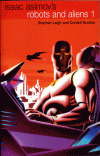A man wakes up in an escape pod with no memory, and only his space suit with Derec written on it to tell him what his name is. He has no memory whatsoever of anything before he woke up. The main plot of the series revolves around Derec’s search for his identity and a way to recover his memory. We are introduced to robots that don’t necessarily behave how we would have thought. They do obey the Three Laws but there are new twists involved. We also get to see aliens, something that Asimov had not really explored in his own writing. Overall, there is quite a bit of action in this first book and it should keep you interested enough to finish the rest of the series.
Isaac Asimov’s Robot City Book 1: Odyssey by Michael P. Kube-McDowell
1 thought on “Isaac Asimov’s Robot City Book 1: Odyssey by Michael P. Kube-McDowell”
Leave a Reply
This site uses Akismet to reduce spam. Learn how your comment data is processed.
Related Post
Daneel Olivaw, Guardian of HumanityDaneel Olivaw, Guardian of Humanity
R. Daneel Olivaw is my favorite character from the Robot and Foundation Universe created by Isaac Asimov. The R stands for “Robot,” but he became much more than that over the course of the Robot and Foundation series. Hari Seldon from the Foundation Novels ranks a close second, but my heart goes to Daneel and the Three Laws of Robotics. I’m amazed at how many twists can be made based on three relatively simple rules of behavior. Daneel starts as one of the first humaniform robots, but eventually evolves into much more complex being.
The following discussion is filled with spoilers for the entire Robot and Foundation series, so read it with that in mind. (more…)
The Naked Sun by Isaac AsimovThe Naked Sun by Isaac Asimov
This is the second book in the Robot Novel series by Asimov. A year has passed since The Caves of Steel. Lije Baley is summoned once again to solve a murder. The Department of Justice received a request from the Spacers asking specifically for Baley’s help with the case. This time the murder is not on Earth, but on the 50th Spacer world, Solaria. (more…)
Isaac Asimov’s Robots and Aliens Book 1: Changeling by Stephen LeighIsaac Asimov’s Robots and Aliens Book 1: Changeling by Stephen Leigh
One thing I like about this book is there is a nice eight page synopsis of the whole Robot City series. Even after just reading the series, it was a nice refresher for the events leading up to Robots and Aliens. This new series involves Asimov’s challenge to the authors to describe what might happen if robots encountered an alien species. How would they treat them? How would the Three Laws apply?
I particularly enjoyed this first book because it addresses one of the main questions I had regarding the Three Laws of Robotics. What does the key phrase “human being” actually mean? Throughout Asimov’s books and it is explained that the laws aren’t as simple as the English translation. They are complicated sets of positronic potentials that govern every action of a robot.
In Changeling, Stephen Leigh describes a robot model that is given a very simple definition of “intelligent life form” as an equivalent. This idea seems to work very well in this book and after several chapters we see how this experiment intersects with the Robot City plotlines. Also, we get to see Derec use the powers he was given to control Robot City. One thing that did bug me a little bit was how little of the main plotlines was advanced.



I was a little skeptical reading a book based on Asimov’s work, but written by someone else; however, I can tell from the first book that I am going to like the series. This book can be classified as an introduction, and ends with a series of questions and mysteries yet to be resolved. Basically, Derec finds himself on an asteroid with no previous personal memories, but an obvious robotics abilities. Many things about the asteroid’s operations are abnormal. I have some theories already as to what is going to happen, and I can’t wait to see what happens next!